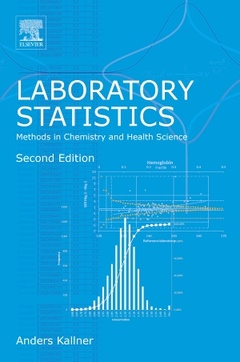Laboratory Statistics (2nd Ed.) Methods in Chemistry and Health Sciences
Auteur : Kallner Anders

Laboratory Statistics: Methods in Chemistry and Health Science, Second Edition, presents common strategies for comparing and evaluating numerical laboratory data. In particular, the text deals with the type of data and problems that laboratory scientists and students in analytical chemistry, clinical chemistry, epidemiology, and clinical research face on a daily basis. This book takes the mystery out of statistics and provides simple, hands-on instructions in the format of everyday formulas. Spreadsheet shortcuts and functions are included, along with many simple worked examples. This book is a must-have guide to applied statistics in the lab that will result in improved experimental design and analysis. This thoroughly revised second edition includes several new sections, more examples, and all formulas in Excel code.
1. Basics2. Distributions of Data3. Permutations, Combinations, Probability, Binominal and Poisson Distributions4. Robust Estimators5. Uncertainty6. Difference Between Results7. Non-Parametric Comparisons8. Analysis of Variance9. Analysis of Variance Components10. Regression11. Correlation and Covariance12. Comparing Quantities13. Performance Characteristics14. Interpretation of the Elements of the ROC Analysis15. Estimation of Minimal Sample Size (Power Analysis)16. Agreement Between Categorical Assessments (Kappa (?)-Statistics) Some Metrological Concepts17. Metrology, Accuracy, Trueness and Precision18. Uncertainty Concept and Uncertainty Budget19. Miscellanea
Analytical and clinical chemists, epidemiologists; researchers in all laboratory science disciplines, physicists, engineers; students in these areas
Dr. Kallner’s scientific work has spanned a wide field ranging from organic synthesis and metabolism of cholesterol to epidemiological and metabolic studies of vitamin D. An interest in quality management and development of routines for quality assessment in the laboratory required studies in programming and statistics. Eventually, Dr. Kallner recognized the need for a compendium of useful statistical procedures and formulas that could easily be used in programming and understanding of statistical procedure.
- Provides comprehensive coverage of simple statistical concepts
- Familiarizes the reader with formatted statistical expression
- Presents simple, worked examples that make formulas easy to apply
- Includes spreadsheet functions that demonstrate how to find immediate solutions to common problems
Date de parution : 10-2017
Ouvrage de 174 p.
15x22.8 cm
Thème de Laboratory Statistics :
Mots-clés :
distributions of data; permutations; probability; binominal and Poisson distributions; robust estimators; non-parametric comparisons; analysis of variance; regression; correlation; covariance; ROC analysis; minimal sample size; power analysis; categorical assessments; Kappa-statistics; ?-statistics; metrology; uncertainty concept; uncertainty budget



